OnlinWith the rise of online education, digital entrepreneurship, and content creation, platforms like Podia have gained traction among creators and small business owners.
Podia is an all-in-one platform that enables creators to sell online courses, memberships, and digital products without requiring technical expertise or juggling multiple tools. But does it live up to its promise of simplicity and effectiveness?
In this Podia review, I’ll explore Podia’s key features, pricing, benefits, and drawbacks, along with a guide on how Podia works. By the end, you’ll know whether Podia is the right fit for your digital business.
Content Outline
What is Podia?
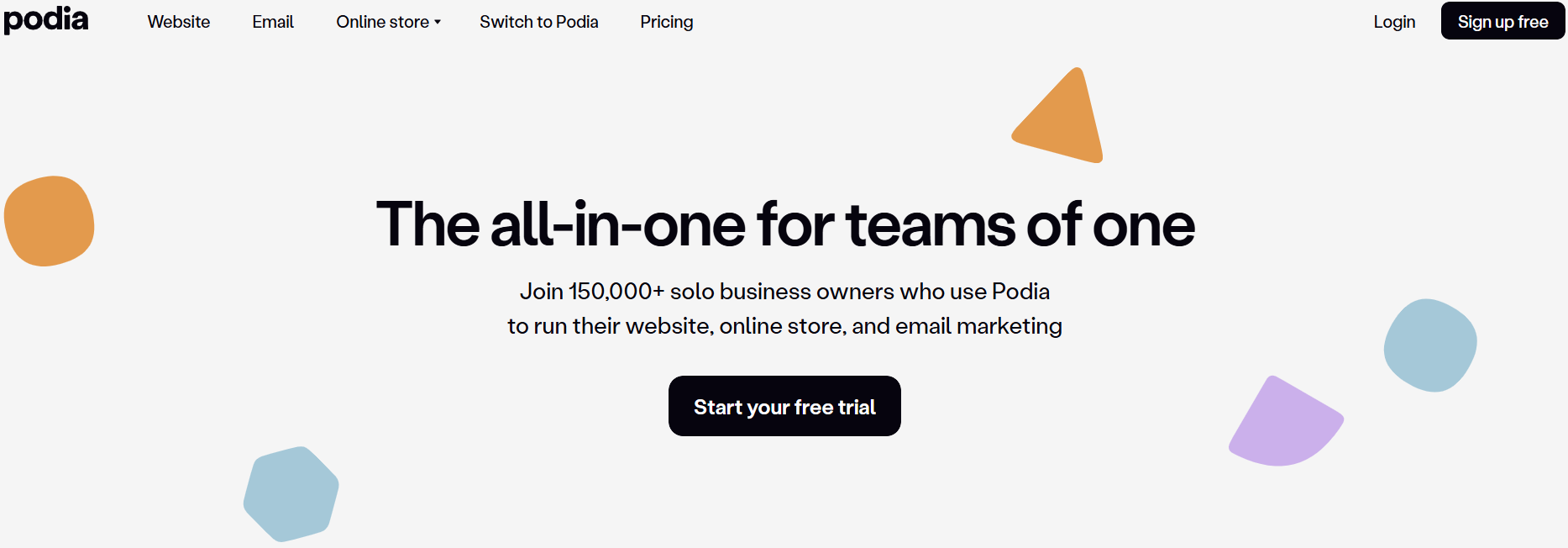
Podia is a digital platform that enables creators to sell courses, memberships, and digital downloads while offering built-in marketing tools. It’s designed to be a one-stop shop for entrepreneurs, coaches, educators, and artists who want to monetize their content without dealing with complex integrations.
With Podia, you can:
- Build and sell online courses.
- Offer membership subscriptions.
- Sell downloadable digital products like eBooks, templates, and guides.
- Conduct live webinars or online events.
- Manage email marketing and customer communication.
Whether you’re new to selling digital products or a seasoned pro, Podia aims to provide a user-friendly experience that minimizes the technical workload.
How Does Podia Work?
Podia operates as a comprehensive, all-in-one platform that guides users through every step of digital product creation, marketing, and sales. Here’s a step-by-step breakdown of how Podia works:
- Sign Up and Choose a Plan: Start with a free trial or choose one of Podia’s plans—Mover or Shaker. Each plan offers varying levels of features, so you can select the one that best meets your needs.
- Build Your Website: Podia allows you to create a customizable website where you can showcase your brand, products, and services. The drag-and-drop interface makes it easy to create pages without needing design skills.
- Create Digital Products: Whether it’s an online course, membership, or digital download, you can start building your product right away. Podia’s course builder supports video, audio, text, and quizzes, so you can create engaging, multimedia-rich content.
- Set Up Payment Options: Podia integrates with popular payment processors like Stripe and PayPal, allowing you to receive payments seamlessly.
- Launch Email Marketing Campaigns: Use Podia’s built-in email marketing tools to create and send newsletters, automate email sequences, and engage with your customers.
- Promote with Sales Tools: You can offer discount codes, bundle products, and set up upsells to boost revenue.
- Manage Orders and Customers: Podia provides an intuitive dashboard to help you track sales, manage customer data, and analyze engagement with your products.
Once you’ve created your products and set up payment and email marketing, Podia becomes a centralized hub where you can manage everything from content creation to customer support.
Podia Pricing: Updated Plans and What They Include
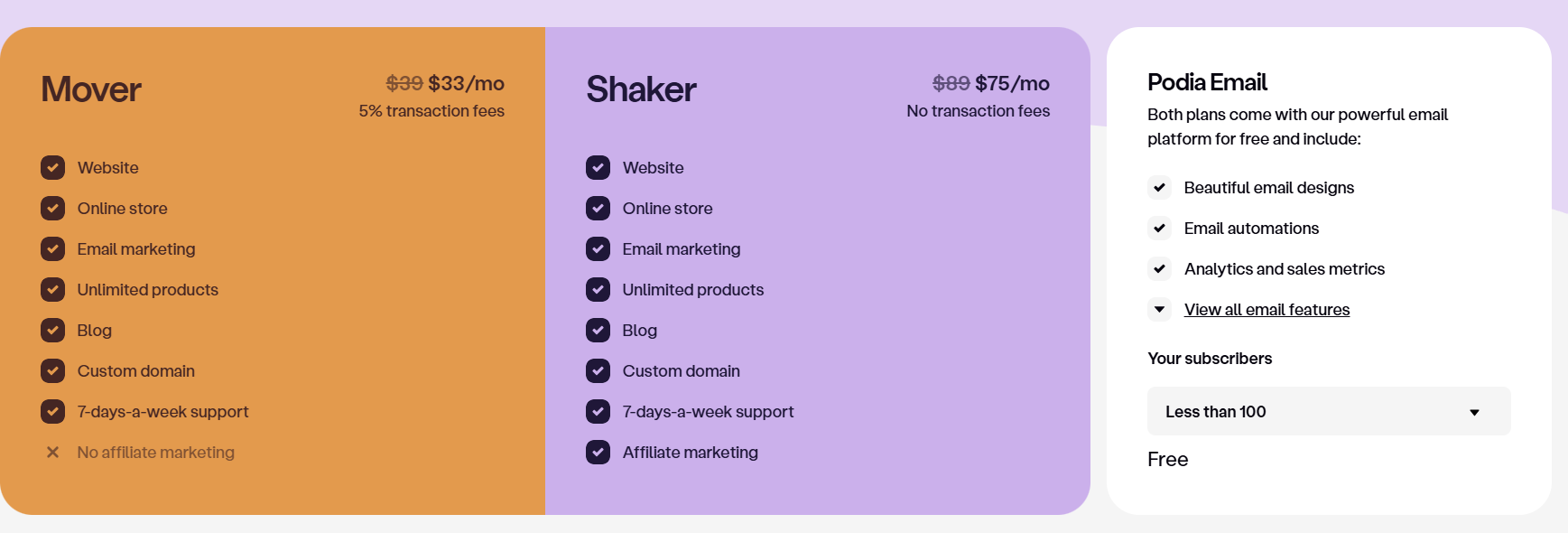
Podia offers two main plans—Mover and Shaker—each catering to different types of creators and businesses. Here’s a detailed breakdown of what each plan offers:
1. Mover Plan – $33/month (Regular Price $39/month)
- Features:
- Full-featured website creation.
- Online store with unlimited products.
- Email marketing with beautiful designs, automations, and analytics.
- An integrated blog to attract organic traffic.
- Custom domain for brand alignment.
- 7-day support.
- Transaction Fee: 5% transaction fee on sales.
- Ideal For: Creators who are just starting and need essential tools without extra bells and whistles.
2. Shaker Plan – $75/month (Regular Price $89/month)
- Features:
- Everything in the Mover plan.
- Affiliate marketing to incentivize referrals.
- Advanced email marketing features.
- No transaction fees, meaning you keep 100% of your revenue.
- Transaction Fee: No transaction fees.
- Ideal For: Established creators and businesses who want more marketing options and control over their revenue.
Podia Email is included in both plans and allows creators to use powerful email marketing features, such as:
- Beautiful email templates.
- Automation sequences to nurture leads.
- Sales and analytics tracking.
Additionally, Podia’s email marketing is free for creators with less than 100 subscribers, making it an affordable choice for beginners.
Key Features of Podia: What Makes It Unique?
Podia’s robust feature set caters to a wide variety of creators. Here’s an in-depth look at the standout features that make Podia an attractive platform.
1. Intuitive Course Creation and Drip Content
Podia’s course builder allows creators to easily add different types of content to each lesson, including video, audio, text, quizzes, and downloadable files. Podia also offers the ability to drip content—releasing lessons over time—keeping students engaged, and preventing them from rushing through the course.
2. All-in-One Membership Functionality
Podia’s membership feature lets creators build a community by offering exclusive access to members. You can create multiple membership tiers, each with different levels of access, perks, or content. This feature is particularly valuable for creators who want to offer ongoing value to their subscribers, such as exclusive content or community discussions.
With Podia’s membership capabilities, you can:
- Run a community with ongoing content.
- Segment access to content based on membership tiers.
- Engage with members and build long-term relationships.
3. Digital Downloads and Product Bundling
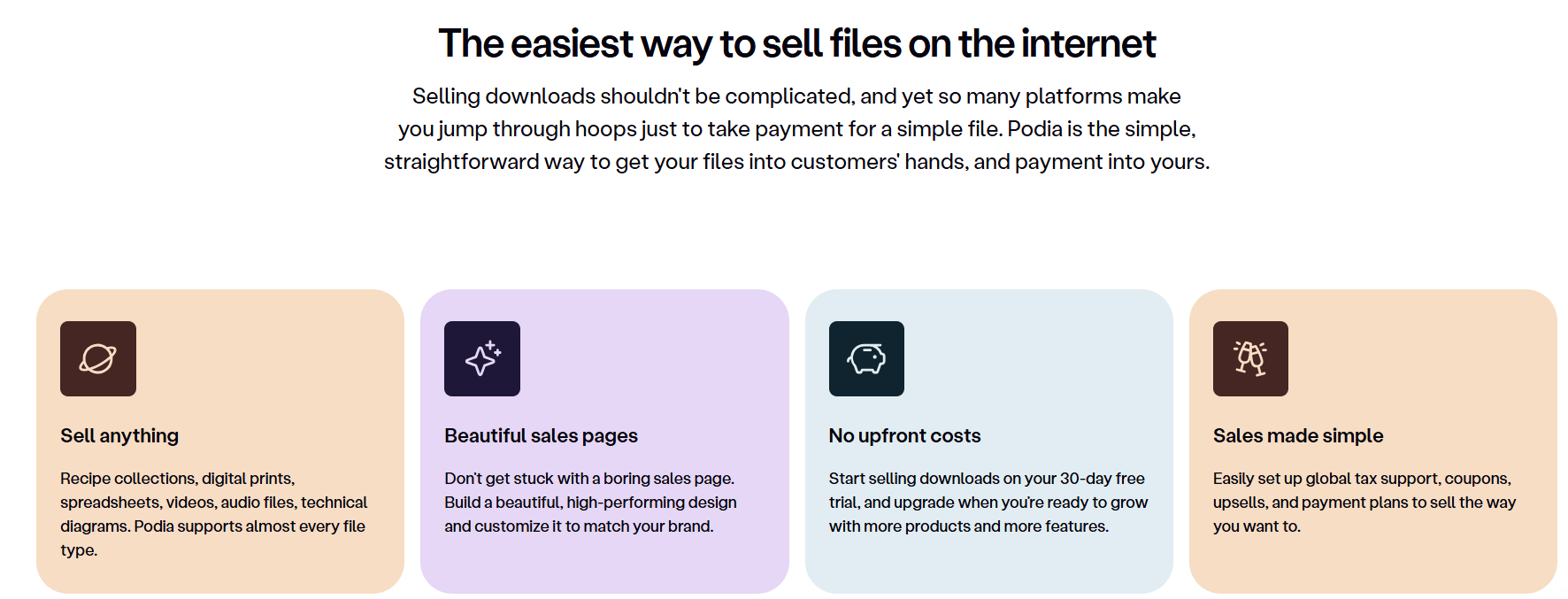
For creators who want to sell digital products like eBooks, templates, or guides, Podia makes it easy. You can upload files and set prices without restrictions. Additionally, Podia’s product bundling feature allows you to group multiple products for sale as a package, which is a great way to increase sales.
4. Integrated Email Marketing
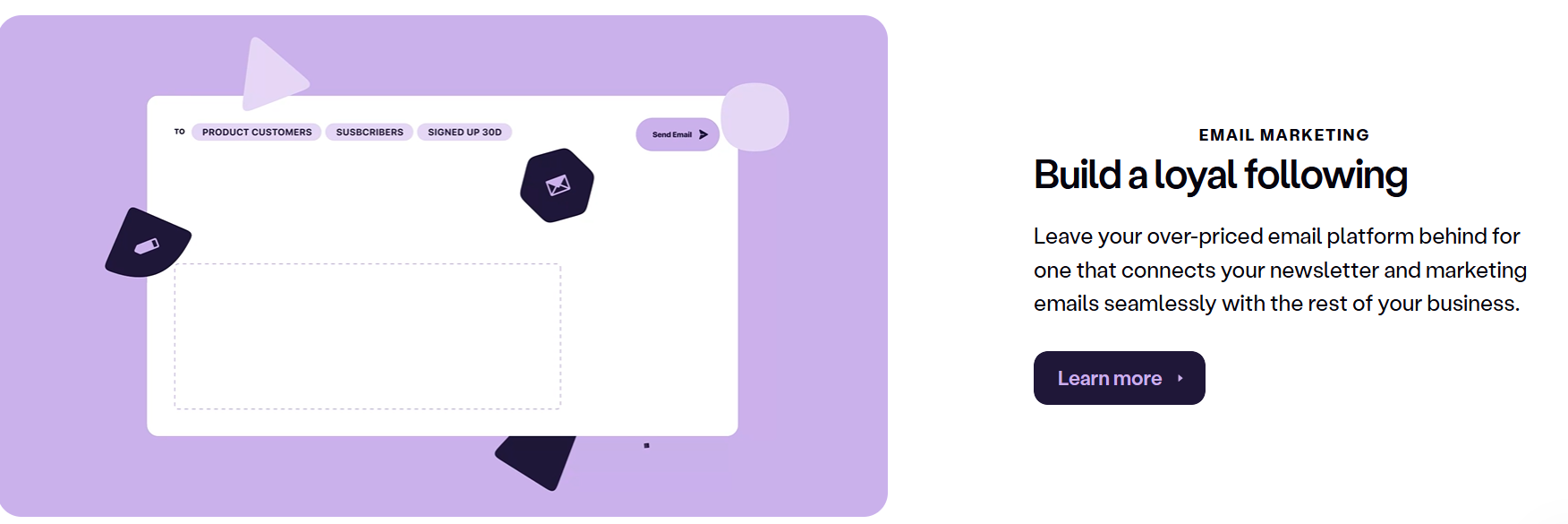
Podia’s built-in email marketing tool eliminates the need for a separate email service provider. With Podia, you can create newsletters, set up automated drip sequences, and segment your audience based on their purchases. This is especially useful for nurturing leads and promoting new products directly from the platform.
5. Built-In Sales and Marketing Tools
Podia provides tools like coupon codes for discounts, upsell options to increase sales, and pre-orders for new products. These tools are designed to make it easy for creators to increase revenue and customer lifetime value. Affiliate marketing, available on the Shaker plan, enables creators to incentivize referrals by allowing affiliates to earn commissions on sales.
6. Host Webinars and Live Events
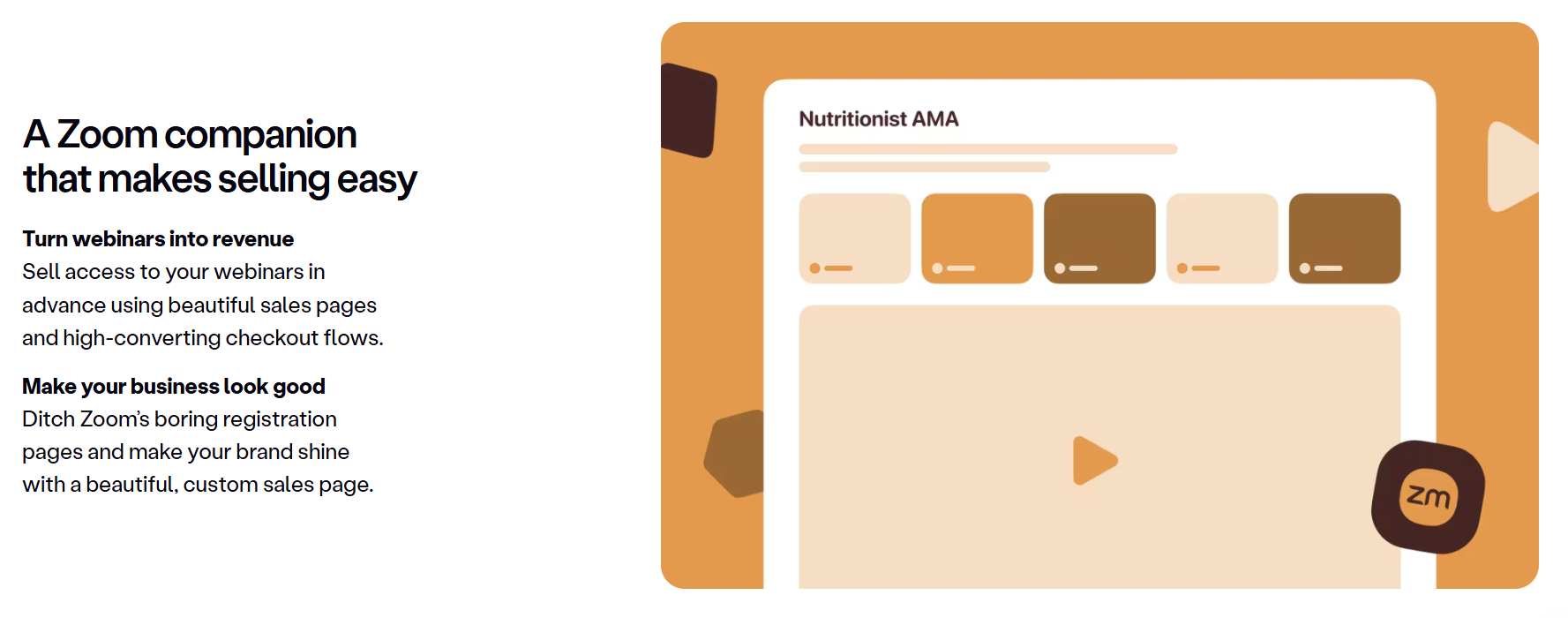
Podia’s webinar feature is ideal for creators who want to host live Q&A sessions, workshops, or product launches. It integrates with Zoom, allowing creators to offer a seamless live experience and build stronger relationships with their audience. Webinars can also serve as lead-generation tools, helping creators capture new subscribers who attend the live event.
7. Customizable Website and Landing Pages
Podia allows users to create a branded website where they can list all their products. While it doesn’t offer the advanced customization options found in dedicated website builders, Podia provides enough design flexibility for most creators to build a professional-looking site. You can customize layouts, add custom branding, and set up individual landing pages for each product.
Servies Podia Offers:
1. Website Builder
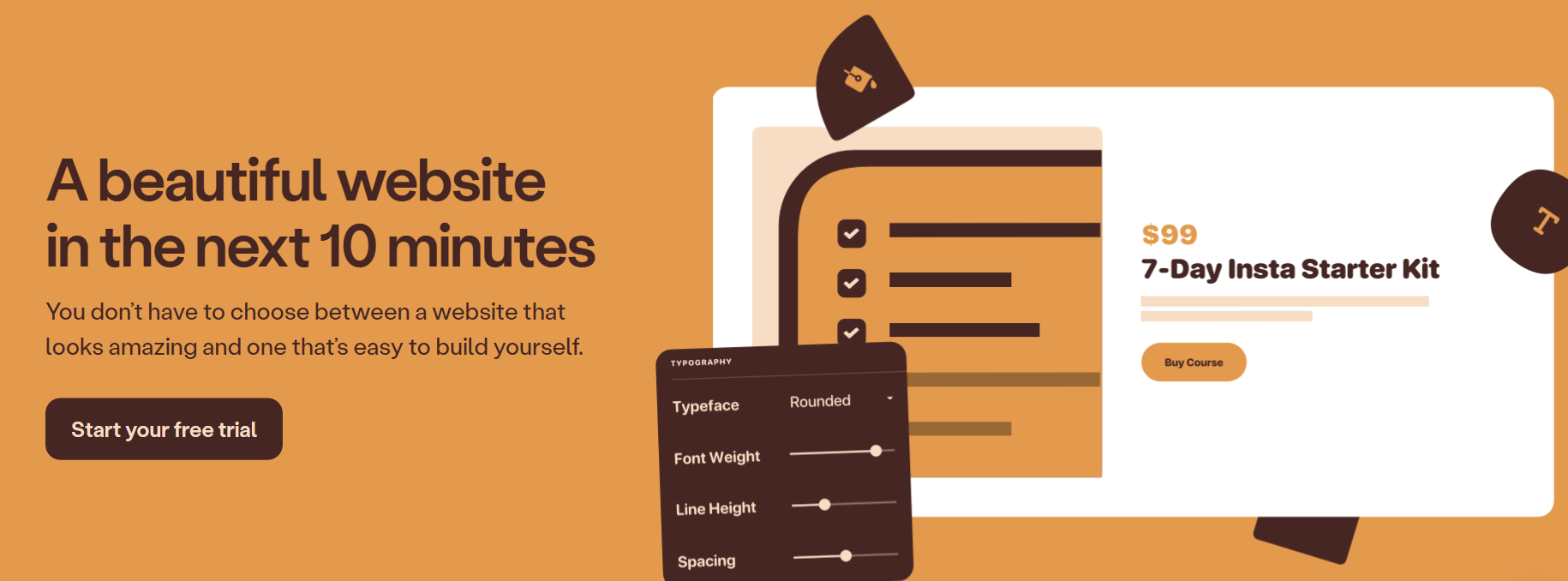
Podia’s website builder is intended to provide designers with a simple approach to creating a website that looks professional without requiring technical know-how.
The platform offers customization choices, like changing fonts, colors, and fundamental layout components, to represent unique branding. The simple and contemporary default template guarantees that websites look good right out of the box, even if it doesn’t offer sophisticated design freedom.
Additionally, the builder offers SSL certificates and custom domains, adding professionalism and security. In order to share material and interact with their audience, producers may also include a blog on their website.
2. Online Builder
With its built-in web store, Podia lets developers sell a range of digital goods. Online courses, memberships, digital downloads, and webinars are all supported by the platform, which also provides various pricing choices including payment plans, one-time purchases, and subscriptions.
The checkout procedure is simplified and accepts international payments to serve a large customer base. Podia also offers resources for launching sales-boosting promotions, such as discounts and coupon codes. Crucially, creators are able to keep 100% of their revenue since the platform does not impose transaction fees.
3. Email Marketing

Creators can efficiently interact with their audience and advertise their goods using Podia’s integrated email marketing solutions.
The application enables users to create automatic drip campaigns to gradually nurture leads and send broadcast emails to announce launches or upgrades.
On the basis of behaviour or past purchases, Podia’s segmentation features allow producers to target particular audience segments. Users may monitor and improve their email campaigns with the use of performance metrics, such open and click-through rates, which guarantee that their audience is effectively communicated with.
Who is Podia Best Suited For?
Podia is built to cater to a wide variety of creators, but certain user groups will benefit more than others:
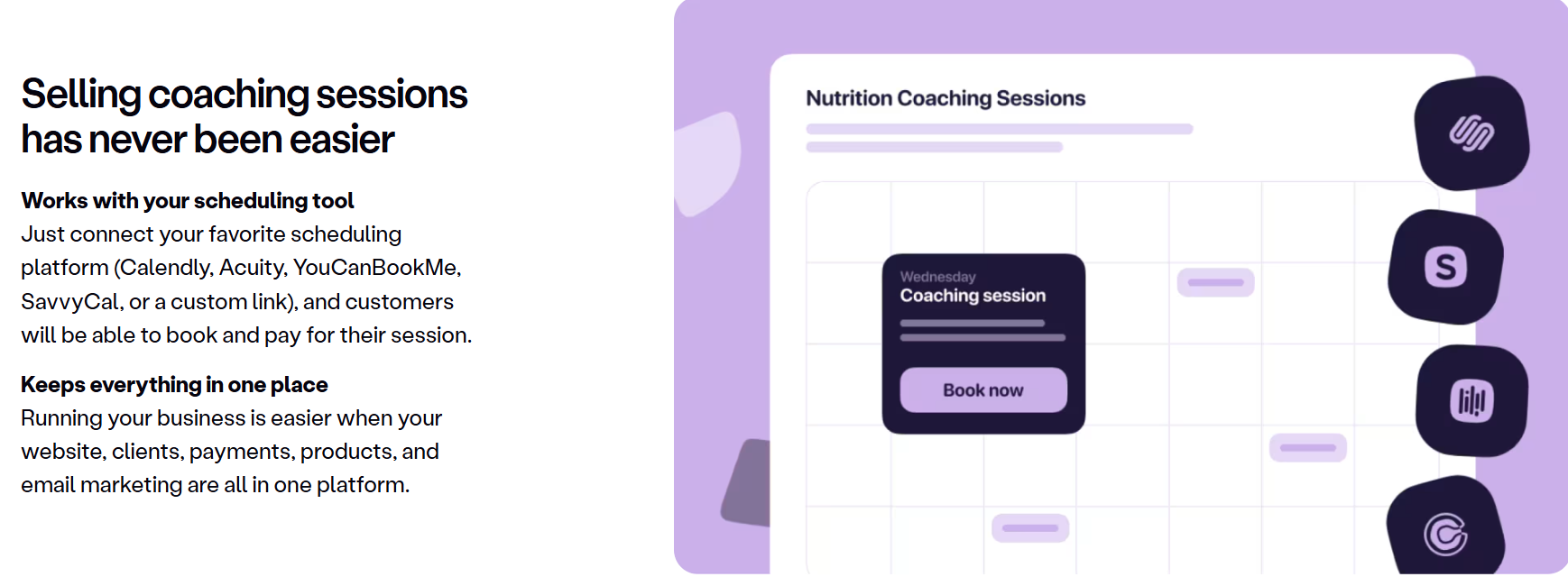
- Educators and Coaches: Podia’s course builder, drip content, and membership features make it ideal for teachers and coaches who want to provide structured content or community-based learning.
- Artists and Digital Creators: Podia supports the sale of digital downloads, making it perfect for artists and creators who sell eBooks, templates, or downloadable files.
- Influencers and Content Creators: With memberships, affiliate marketing, and integrated email tools, Podia is a strong option for influencers who want to monetize exclusive content and connect directly with followers.
- Freelancers and Small Business Owners: Podia’s simplicity and lack of transaction fees (on the Shaker plan) make it a practical option for freelancers and small businesses that sell online services or digital products.
Podia’s simplicity and all-in-one design also make it a good choice for creators who don’t want to spend time managing multiple tools or integrating services.
Podia Integrations
Podia is a platform for creators to sell online courses, digital downloads, and memberships. It offers various integrations to help users connect with other tools for marketing, payment processing, and communication.
Here are some of the common integrations Podia supports:
1. Email Marketing Integrations
- Mailchimp: Automate email campaigns, manage subscribers, and nurture your audience.
- ConvertKit: Connect your Podia account with ConvertKit to grow your email list and send personalized email sequences.
- AWeber: Another popular tool to help manage email campaigns and grow your email list.
- SendGrid: Use SendGrid for email delivery and transactional emails.
- ActiveCampaign: Integrate for advanced email marketing and customer relationship management.
2. Payment Processing
- Stripe: Podia uses Stripe for payment processing, allowing you to accept credit and debit card payments securely from around the world.
- PayPal: You can also integrate PayPal to accept payments, providing customers with more payment options.
3. Zapier
- Zapier: Automate tasks and integrate Podia with over 2,000 other apps, like Google Sheets, Slack, and more. This allows for automating workflows without needing to write code.
4. Calendly
- Calendly: Integrate with Calendly to schedule meetings and one-on-one sessions with your students or clients directly through Podia.
5. Google Analytics
- Google Analytics: Track your website and course traffic to gain insights into your audience behavior and sales performance.
6. Facebook Pixel
- Facebook Pixel: Use Facebook Pixel to retarget ads to people who have visited your course pages or interacted with your content.
7. Stripe Connect
- Stripe Connect: If you’re running a marketplace or working with affiliates, Stripe Connect allows you to manage payouts and handle payments easily.
8. Affiliate Programs
- Podia’s Built-in Affiliate System: You can create your own affiliate programs directly in Podia to incentivize others to promote your products.
9. Webhooks
- Webhooks: For advanced users, Podia allows you to use webhooks to send data from Podia to other apps and services.
10. Social Media
- Facebook and Instagram: You can use Podia to share your courses on social media platforms to drive traffic and sales.
11. YouTube & Vimeo
- Podia allows you to embed videos from YouTube and Vimeo, helping you use external video content in your courses.
12. Other Integrations
- Teachable: Podia integrates with Teachable, allowing for seamless content import between the two platforms.
- Google Sheets: Automate data collection, like student sign-ups, into Google Sheets.
Pros and Cons of Using Podia
Pros
- There is no transaction fee on the shaker plan.
- Begiiner-friendly.
- Integrated email marketing.
- Multiple Revenue streams
- Affordable
- Live Support.
Cons
- Limited Customization.
- Basic Analytics
- No free plan
- No phone support
Podia’s Registration & Administration:
Managing courses, students, and tracking performance metrics are essential features for any online course platform. Here’s an overview of what Podia offers in terms of reporting and administration:
1. Reporting and Analytics
Podia’s reporting capabilities are quite basic and lack depth, especially when compared to some of its competitors. Here’s what you can expect:
Student Progress Tracking: Podia allows you to monitor individual student progress. You can view completion rates for specific students and track which lessons they’ve completed. However, it does not provide insights into overall course performance or average course completion rates.
Missing Analytics for Course Engagement: There is no way to track student engagement metrics such as:
- Average course completion rates
- Video watch times
- Drop-off points in videos
Sales Reporting: Podia includes a separate dashboard for store sales. The dashboard allows you to:
- Filter sales by specific products or plans.
- View individual transactions.
Export sales data in CSV format. However, the sales reporting tools lack advanced filters for dates, coupon codes, or affiliates. There are also no visual tools to compare product performance or track sales trends over time.
Overall, Podia’s reporting tools provide only a high-level overview and do not support detailed analytics or data-driven insights for courses or sales performance.
2. People Management
Podia makes managing your audience relatively simple with its Audience section. Here’s what you can do:
Audience Overview: View and filter users based on categories such as:
- Email subscribers
- Paid customers
- Community members
Additional Filters: Refine the audience list using criteria like courses they’ve enrolled in, purchase totals, or email activity.
User Profile Management: By clicking on a user, you can access their profile, which displays:
- Products and plans purchased
- Tags associated with the user
- Progress in their purchased products You can also:
- Edit user information
- Add or remove tags
- Reset passwords
- Remove product access
- Delete user accounts
Bulk Actions: Apply tags, unsubscribe, or delete multiple users at once. However, you cannot enroll or unenroll users in bulk, which is a notable limitation.
3. User Roles
Podia allows you to add team members with customizable access levels:
- Assign team members specific permissions by selecting which sections of the Podia app they can access. For example, you can grant a Virtual Assistant access to all areas except sales reports.
- No Course Author Role: Podia does not support a dedicated course author role. If you want to sell courses from multiple authors and share revenue with them, this is not possible within the platform.
Podia Site Design and Customization
Podia provides a hosted platform for online courses and digital products, including hosting, SSL certificates, and a customizable domain. While it delivers the essentials for building a functional and visually appealing website, it comes with notable limitations in design flexibility. Here’s a detailed look at Podia’s site design and customization capabilities:
1. Website Basics
- Hosting and SSL: Every Podia plan includes hosting and SSL certificates, ensuring secure and professional-looking websites.
- Domain Options: By default, your website uses a free Podia subdomain, but you can connect a custom domain to personalize your brand.
- White-Labeling and Localization: Podia supports white-labeling, allowing you to remove Podia branding, and offers options to change the site language for a localized experience.
2. Website Themes
Podia offers a single default website template with no additional themes. While this may limit design variety, the default template features a clean, modern aesthetic.
Site-Level Customizations:
- Add a logo and favicon.
- Adjust header styles.
- Modify color schemes.
- Change default fonts for body text and headings.
- Make minor layout adjustments, such as padding and margins.
However, Podia doesn’t provide access to the backend for advanced customizations like editing CSS or HTML, restricting flexibility for experienced developers.
3. Page Builder
Podia’s page builder is user-friendly and designed for quick page creation. While it lacks the flexibility of drag-and-drop builders, it offers structured options to design pages.
Pre-Built Sections: Includes sections for:
- Product banners
- Course descriptions
- Author bios
- FAQs
- Testimonials
- Pricing plans
- Email forms
- Text, images, and videos
Customization Options:
- Adjust size, padding, margins, height, alignment, and colors within sections.
- Reposition elements (e.g., move a media element to the left, right, above, or below the text).
Limitations:
- Inability to freely add, remove, or rearrange individual elements within sections.
- No animation effects or separate mobile layout editing.
- Can’t mix elements (e.g., adding a video to an email form or an email form to a banner section).
Despite these restrictions, Podia’s page builder is sufficient for creating visually appealing storefronts and sales pages quickly.
4. Blogging Tools
Podia includes basic blogging functionality, allowing users to create and publish blog posts.
Content Creation:
- Use a simple text editor to write content, add images, embed videos, and format text.
- Add a featured image and SEO details (title, description, etc.).
- Publish immediately or schedule posts.
Customization: Blog pages and posts can be customized using the page builder.
Limitations:
- The text editor lacks advanced formatting options like custom fonts and colors.
- No options for tagging or categorizing blog posts.
- Limited in functionality compared to dedicated blogging platforms like WordPress or Squarespace.
- Podia’s blogging tools are adequate for hosting a simple blog but may not suit users with advanced content management needs.
Comparing Podia to Competitors
Podia competes with platforms like Teachable, Kajabi, and Thinkific. Here’s a brief comparison:
- Podia vs Teachable: Teachable offers more advanced course creation features, such as certificates and completion tracking. However, Podia includes memberships and email marketing without transaction fees on higher plans.
- Podia vs Kajabi: Kajabi is more expensive but offers highly customizable website design and advanced marketing features. Podia, on the other hand, is simpler and more budget-friendly.
- Podia vs Thinkific: Thinkific is more focused on course creation with detailed student reporting and customization. Podia is better suited for creators looking for an all-in-one solution that includes memberships and digital downloads.
Quick Links,
Final Verdict: Is Podia Right for You?
Podia is a well-rounded platform ideal for creators who want an all-in-one solution to sell courses, memberships, and digital products. Its focus on simplicity, affordability, and lack of transaction fees (on the Shaker plan) make it a great choice for beginners and small business owners.
The integrated email marketing, webinars, and affiliate marketing features further add to its appeal, providing value that would typically require multiple tools.
However, users looking for advanced customization, in-depth analytics, or phone support might find Podia’s limitations challenging. For most creators, though, Podia delivers on its promise as a reliable, affordable, and powerful tool for building an online business.
